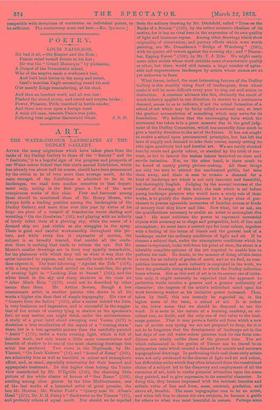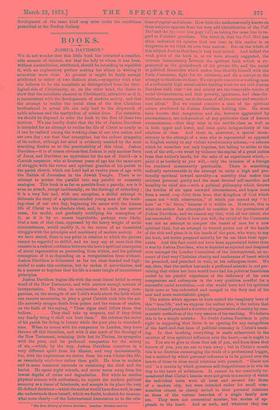ART.
THE WATER-COLOUR LANDSCAPES AT THE DUDLEY GALLERY.
ArrExt the many migrations which have taken place from the ranks of the Dudley Gallery to those of the " Society" and the " Institute," it is a hopeful sign of the progress and prospects of our Water-colour School that this ninth annual Exhibition, which has already run about half its course, should have been pronounced by the critics to be of even more than average merit. As the main strength of the Exhibition is admitted to lie in its landscapes, we shall here confine ourselves to that depart- ment only, noting in the first place a few of the most conspicuous works of this class. First and foremost among these should be mentioned those of Mr. Henry Moore, who always holds a leading position among the landscapists of the Dudley Gallery, and more than ever this year by virtue of his large sea piece of a turmoil of treacherous waves chafing and wrestling " On the Goodwin" (83), and playing with an infinity of lovely reflex tints of a glowing sky, while the masts of a doomed ship are just visible as she struggles in the spray. There is good and careful workmanship throughout this pic- ture, and while every line is expressive of motion, the subject is so broadly treated, that amidst all the confu- sion there is nothing that tends to irritate the eye. But Mr. Moore's smaller drawings are in their way equally remarkable, for the plainness with which they tell us what it was that the artist intended to express, and the masterly truth with which he does express it. The boat labouring " Against the Tide" (318), with a long rainy white cloud settled on the coast-line, the glow of evening light in "Looking East at Sunset" (364), and the white break in the sky and sharp shadows in the clear air " After Much Rain " (278), could not be described by other
names than these. Mr. Arthur Severn, though a less consummate artist, is another painter who shows in all his works a higher aim than that of simple topography. His view of " Geneva from the Saleve" (130), after a sunset behind the Jura, is very luminous and impressive, and is successful in the sugges- tion of the extent of country lying in shadow at the spectator's feet, no easy matter, one might think, under the circumstances. A study of a great lurid cloud sweeping over Venice (379) is doubtless a true recollection of the aspect of a " coming storm" there, but is a less agreeable picture than the carefully-painted " Assisi " (172), under a warm evening light, which is full of delicate work, and only wants a little more concentration and breadth of shadow to be one of the most charming drawings this artist has produced. Two views in the Highlands, by Mr. Vincent, "On Loch Kishorn" (18), and "Sound of Rasay" (348), are admirably true as well as beautiful in colour and atmospheric effect, and, as usual, especially noteworthy for their learned and appropriate treatment. To this higher class belong the Venice view contributed by Mr. D'Egville (349), -the charming little picture of the white cluster of houses of " San Remo" (559), nestling among olive groves by the blue Mediterranean, one of the last works of a lamented artist of great promise, the late Mr. Herries ; Mr. Walter Field's " Quarry near St. Alban's Head " (572), Mr. E. H. Fahey's "Backwater on the Thames "(61), and probably others of equal merit. Nor should we be repelled
from the solitary drawing by Mr. Ditchneld, called "Trees on the Banks of a Stream " (103), by the rather eccentric idealism of its motive, for it has no rival here in the expression of its own quality of light and luminous repose. Among other drawings which show originality of observation, and portray effects which were worth painting, are Mr. Donaldson's " Bridge of Wurzburg " (240), with its quaint old towers against the evening sky ; and "Decem- ber, Epping Forest" (169), by Mr. T. J. Ellis. We might easily name other artists whose work exhibits some characteristic quality or other, but there would still remain a large number of agree- able and unpretentious landscapes by artists whose names are we yet unknown to fame.
What forms, indeed, the most interesting feature of the Dudley Gallery is this steadily rising flood of landscapists, from whose- ranks it will be more difficult every year to step out and attain to- distinction. A constant advance like this, obviously the result of much industry applied in one direction, in answer to a continuous demand, seems to us to indicate, if not the actual formation of a school of art which may be fairly called a national one, at least- the gradual accumulation of something which may serve for its foundation. We believe that the encouraging form which the- movement has taken is in a great measure due to the good judg- ment of the Dudley Committee, which has assuredly done much to give a healthy direction to the art of the future. It has not sought to evolve a school upon preconceived principles, but has left the laws of supply and demand to take their course, merely setting its- veto upon positively bad and hurtful art. We are rarely shocked here by crude and gaudy colour, or startled by the trick of con- trast, or led to lament the useless labour bestowed on close and servile imitation. Nor, on the other baud, is there much to- be found of merely pretty picture-making. All these things- are only too sure to attract the uneducated public, but take them away, and there is seen to remain a demand for a- kind of landscape art which is not only innocent and beautiful,. but thoroughly English. Judging by the annual increase of the number of drawings of this kind, the task which is set before- young landscape painters who would have a ready sale of their works, is to gratify the desire common to a large class of pur- chasers to possess agreeable mementos of familiar scenes or kinds- of scenery that they know and like. Now what, let us ask, are- the qualifications necessary to enable an artist to accomplish this. task ? He must cultivate the power to represent terrestrial objects with accuracy as to shape and perspective, both of line and atmosphere ; he must have a correct eye for local colour, together with a feeling of the forms of clouds and the general look of a landscape under the ordinary conditions of light and air. If he- chooses a subject that, under the atmospheric conditions which he means to represent, looks well from his point of view, the above is a- tolerably complete epitome of the art required to enable him to perform his task. No doubt, in the manner of doing all this there- is room for an infinity of grades of merit, and so we find, as com- petition increases and more industry is employed in the work, we have the gradually rising standard to which the Dudley collection- bears witness. But as this sort of art is in its essence one of imita- tion only, it might naturally be expected that the approach to- perfection would involve a greater and a greater uniformity of character ; the impress of the artist's individual mind upon his- work becoming weaker as his imitative power increased. Thus, taken by itself, this can scarcely be regarded as, in the higher sense of the term, a school of art. It is rather in the lower sense that we should be disposed to use the- word. It is more in the nature of a training academy, an ex- cellent one, no doubt, and the only one of real value to the land- scape painter. That it may prove a fertile soil from which a new race of artists may spring we are not prepared to deny, for it is. not to be forgotten that the development of landscape art in the last days of our old water-colour painters took its rise from con- ditions not wholly unlike those of the present time. The art which culminated in the genius of Turner can be .traced to an antiquarian taste which created a demand for minute and accurate topographical drawings. In performing their task these early artists were not only awakened to the charms of light and air and colour, but difficulties under which they often laboured from the constrained choice of a subject led to the discovery and employment of all the resources of art, both to confer pictorial attraction upon the scene they painted, and to give expression to its essential character. In doing this, they became impressed with the intrinsic beauties and artistic value of line and form, mate, contrast, gradation, and above all, breadth. The mere topographer rose to be an artist, and when left free to choose his own subjects, he became a guide for others to what was most beautiful in nature. Perhaps some
development of the same kind may arise under the conditions prescribed at the Dudley Gallery.



































 Previous page
Previous page